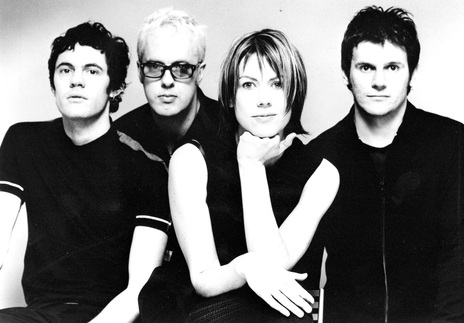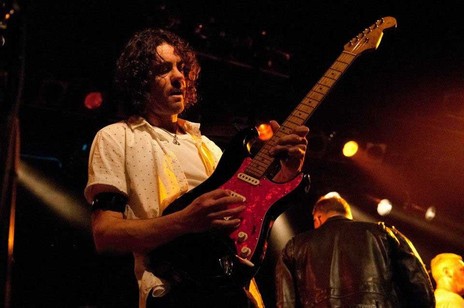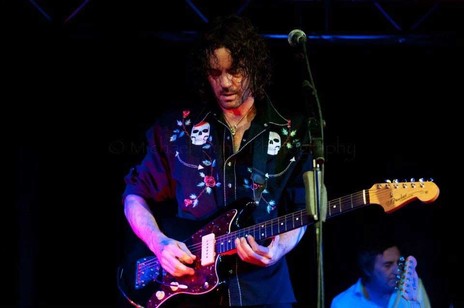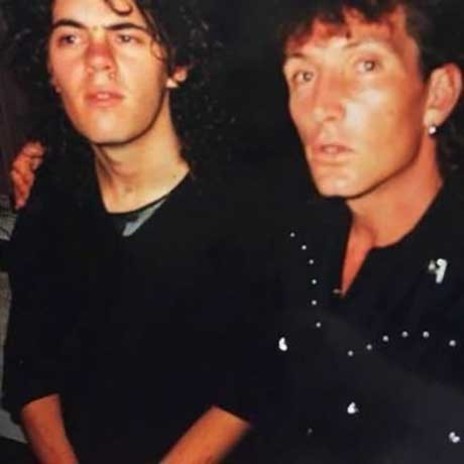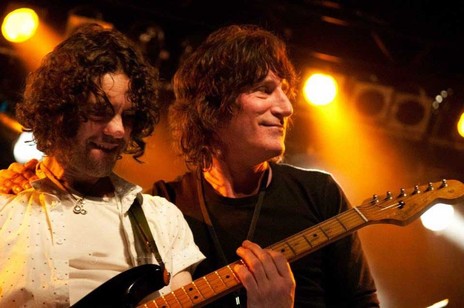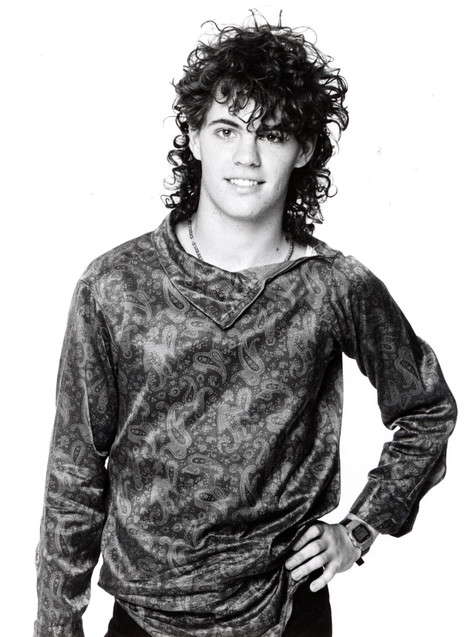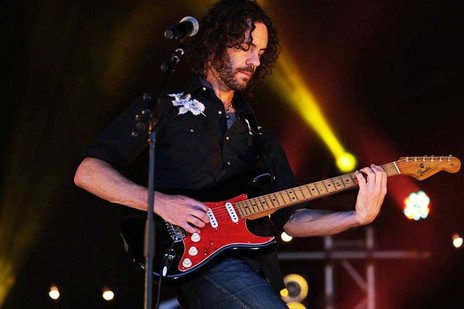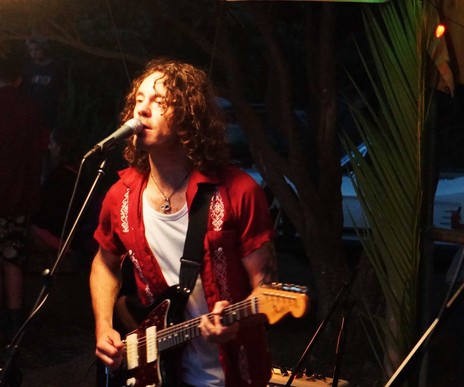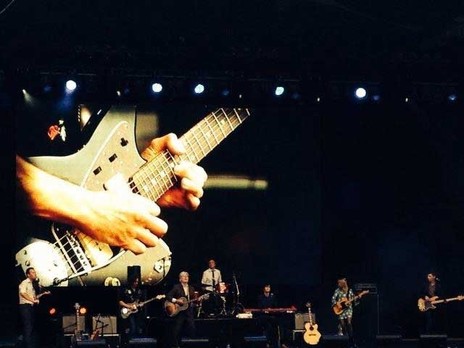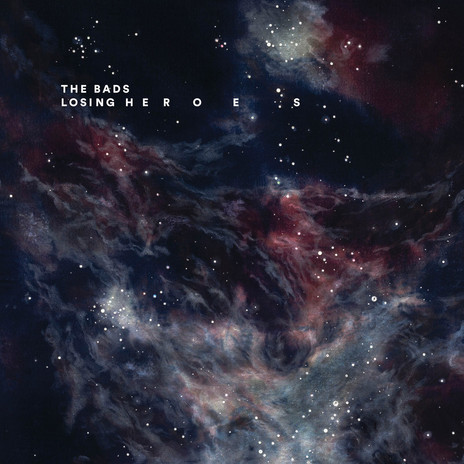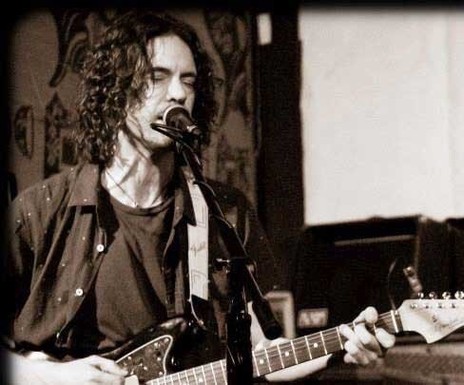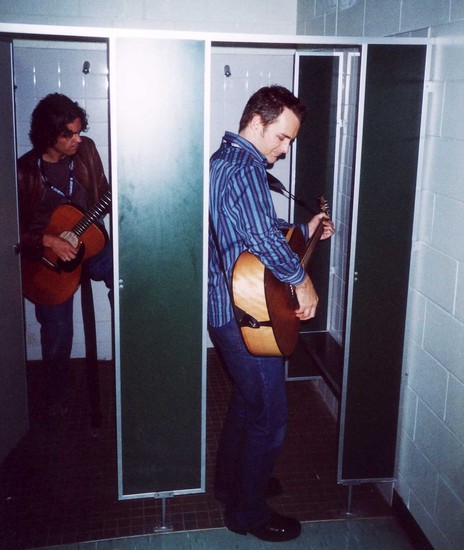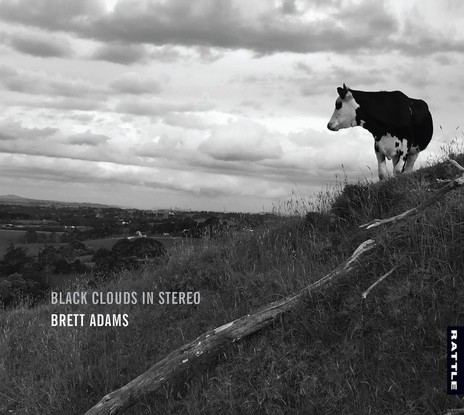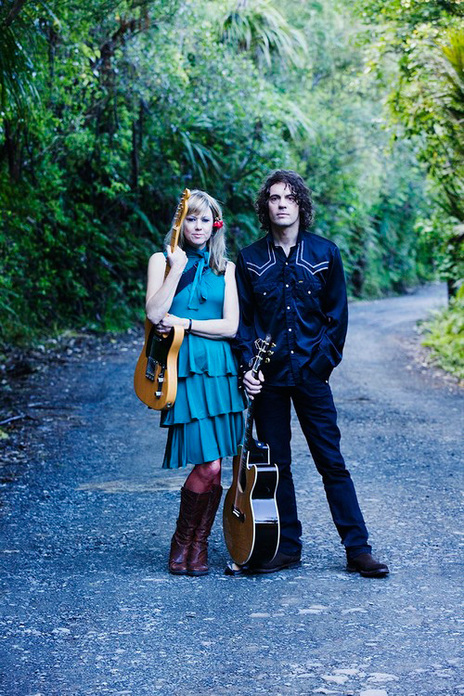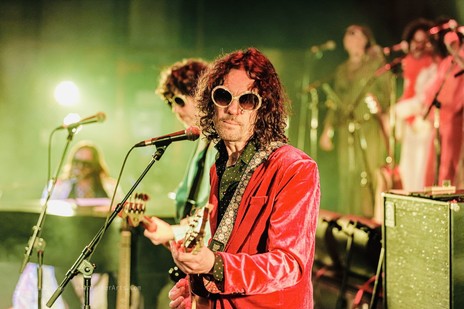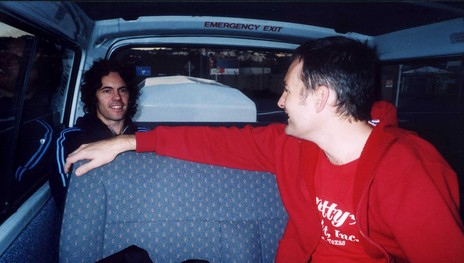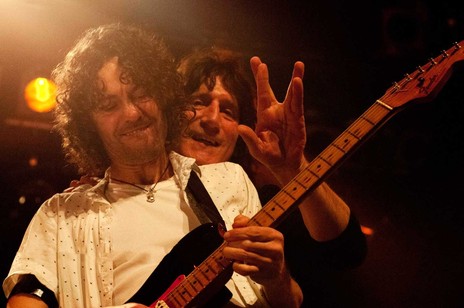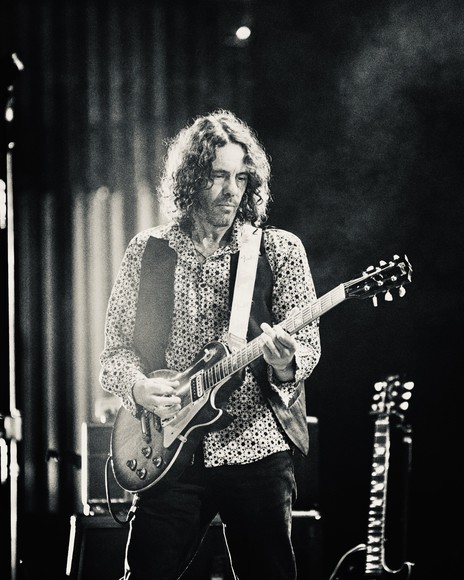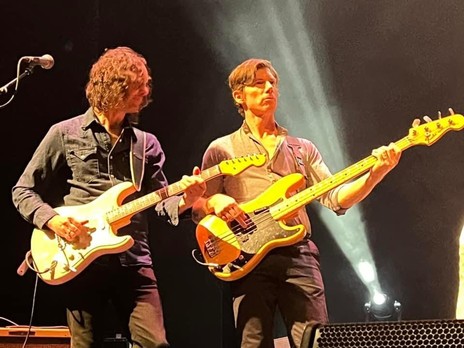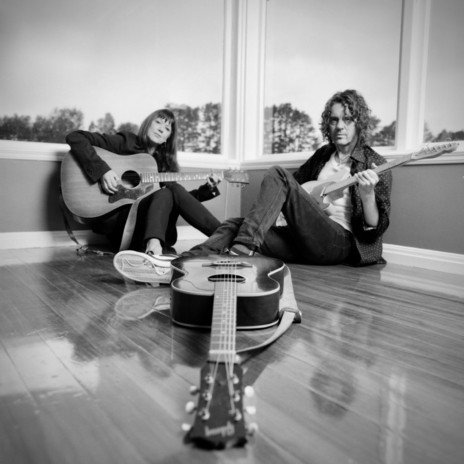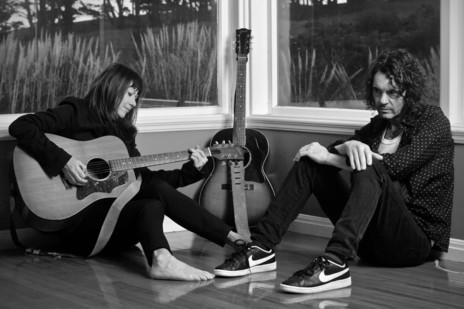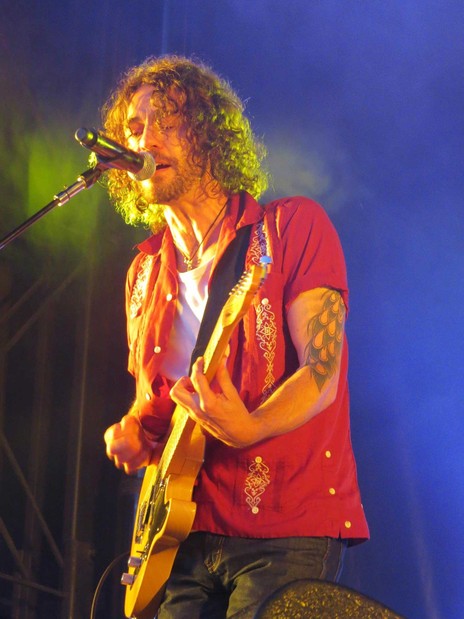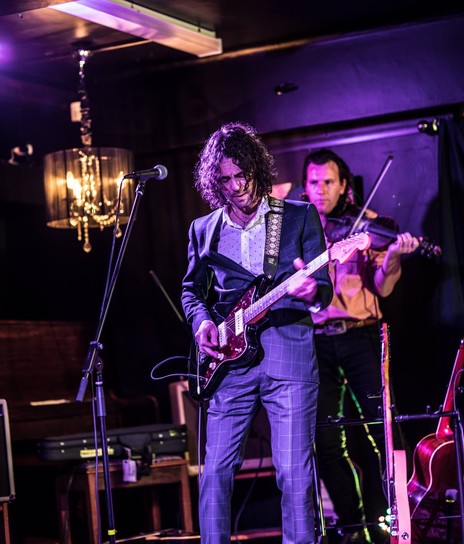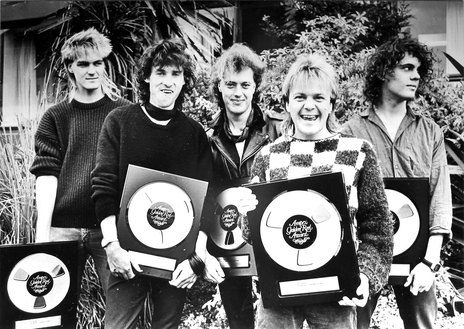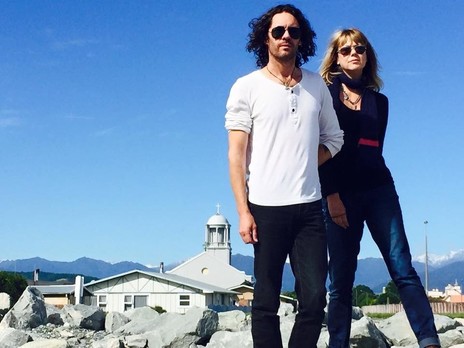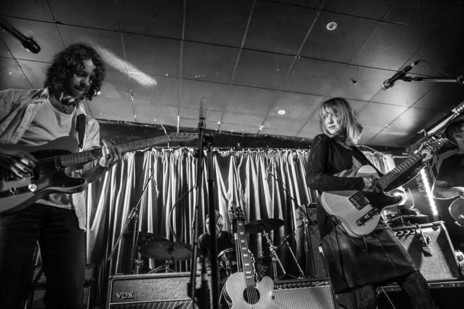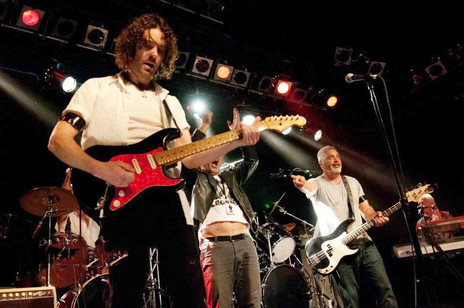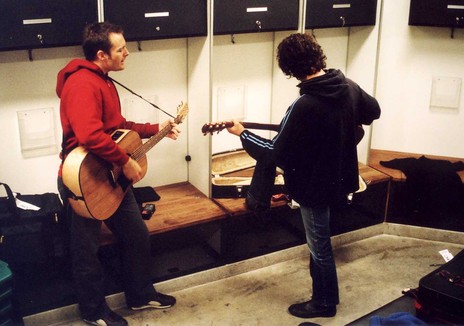The Bads first appeared on New Zealand stages in 2005, releasing their first album Earth From Space and appearing fully formed and fantastic from the get-go. But no one gets to be this good without some serious growing up, which in rock and roll is always done in public. Adams and Swann did a whole lot of theirs overseas.
Some people were familiar with Dianne Swann from Everything That Flies, the band she fronted in the mid-1980s, and from her stint in When The Cat’s Away. Others might recall Adams being the lead guitarist in The Mockers from 1984 to 1989, which is when they packed up and left for London. There, Adams and Swann – with former Mockers bassist Geoff Hayden and Londoner Nick Yeatman on drums – formed The Julie Dolphin in 1992, not long after the Mockers split. Which is when their solid gold dues-paying began.
Brett’s dad wired a guitar lead into a radiogram so he could play – for about 15 minutes
Adams’s commitment to the guitar started pretty early. Every day after walking home from the Taupaki train station (a toilet cubicle-sized corrugated iron hut beside the railroad tracks) in rural West Auckland where he would get dropped after high school, he would play his guitar until late at night.
In the garage between some hay bales and a chest-high freezer was an old radiogram. Adams’s dad had wired a guitar lead into its amplifier input so he could plug his old Hofner through it and play – for about 15 minutes. Then the valves would start to overheat and the tone would get warm and fuzzy, and actually sound pretty damn good for a short while, with a woody tone Jack White would kill for. Twelve minutes in and the distortion would begin to eat the signal, and the guitar would slowly disappear into the fuzz and shrink away like the dot of light when you turn off an old TV set.
“That was a Hofner Galaxy, it had big humbucker pickups with the Hofner logo embossed on them inside a diamond, and a good tremolo system … I swapped my ancient, dangerous old skateboard called a Moonskate, which had the most treacherous trux on it … and 12 dollars. Yup, 12 dollars and a skateboard for my first guitar. I wish I still had it. It was a 1960s guitar, and it was pretty beat up. When we turned up to gigs on the North Shore there were kids with new Ibanez and Aria guitars, they would look at it like, what is this old piece of … I didn’t even have a case for it. Sold it and bought an Ibanez telecaster, $150 dollars from Big City Music, cheapest guitar in the shop. They were both good guitars.”
Adams’s teenage band played at high school dances on Auckland’s North Shore, and rehearsed every weekend at the Kumeu Masonic Lodge, working hard at writing songs and creating a sound. After a Sunday afternoon audition for Russ Le Roq/Russell Crowe, they ended up as a kind of resident band at Crowe’s all-ages club The Venue, on Auckland’s Symonds Street. They played alongside groups that would later morph into the likes of Garageland, and supported local touring acts like The Mockers, The Exponents, and The Wastrels.
It was at The Venue that Adams was spotted by Andrew Fagan and asked to replace Dean Heazlewood as The Mockers’ guitarist, just as their breakout hit ‘Forever Tuesday Morning’ was released. He suddenly found himself playing to large crowds all over the country, during which a friendship and musical partnership was forged with bassist Geoff Hayden that would continue through the next 18 years. He and drummer Steve Thorpe introduced Adams to new influences such as The Cure and The Cramps. Steve’s death in 1986 was unexpected, and a serious blow. “Steve was moody for sure, but his dark moods were usually pretty short … he’d seem to be able to laugh it off pretty fast.”
Recording The Mockers’ second album forced ADAMS to confront his limitations
Recording The Mockers’ second studio album (1985’s Culprit And The King) in Australia forced Adams to confront his limitations and he began to work hard at becoming proficient in a professional recording environment. That focus soon saw him becoming a popular “hired gun”, and the ensuing rigorous touring had him levelling up fast. Meanwhile, The Mockers found themselves tiring of repeating the same concert circuit and set their sights on Britain. But shortly after relocating there, with new drummer/engineer Steve Bush, the band broke up in 1989.
“When the Mockers split I was in London thinking ‘what do I do now?’ Then Dianne [Swann] appeared, she came over for a holiday. We knew each other and liked a lot of the same things, The Pixies, Patti Smith, The Cocteau Twins … and we got talking about writing together. My flat was too depressing, so I’d bring my Les Paul to a park and we’d sit outside in the sun and write songs.” Along with former Mockers bassist Geoff Hayden and Londoner Nick Yeatman on drums, they formed The Julie Dolphin in 1992.
“The Julie Dolphin was a chance to play something darker, more energetic … and also to reflect the experiences of life. After listening to Hüsker Dü and Sonic Youth, even The Cocteau Twins, there were things I wanted to do … but it wasn’t just about reflecting musical influences, it was a chance to write about things inside myself, to express something.
“We had control, we were producing and had free reign. Both Geoff and I played very aggressively… there was no click track; we were just playing very hard. Definitely very spirited! I was let loose, and I really wanted to play the hell out of my guitar.”
This was really the start of Adams’s songwriting. ‘Shell’ off their first EP is the sound of his voice emerging for the first time, and it still shines. Nowadays he and Dianne write together in all possible combinations, and Adams says he most often brings phrases or parts of songs to the table. And though his voice is pretty much half of the vocal presence of The Bads, he doesn’t think of himself as a singer.
“I’m a guitarist – am I a singer? I don’t like to call myself a singer. I sing some of the time, that’s how I like to be, that feels good. But when it comes to the songs, we share a common goal. We listen to what we are working on and try to come up with what the song needs, whatever will help the song be the best it can be. If there’s a good guitar part on the recording that helps the song, I will try and play it live rather than just play the chords.”
The Julie Dolphin released a single (‘Birthday’, 1993), an EP (Roses, 1993) and an album (Lit, 1994) which all received good airplay in the UK. They toured through Europe with Radiohead and played support for the likes of Oasis. The dream-rock outfit eventually morphed into the poppier (though still very loud) Boom Boom Mancini, and signed to Almo Sounds.
After a promising start with songs like ‘Super Model Human’ and ‘Arguments And Alcohol’ getting Radio One airplay and an NME Song Of The Week, Almo decided to abandon some of its development artists. The day before they were to start touring in support of the album, the band was left high and dry. That period spawned too many mad stories to list here. Late night altercations with a drunken Graham Coxon at a London pub; Liam Gallagher popping his head into the band’s dressing room – moments before they went on stage – to tell them Kurt Cobain had died …
Happily, the unreleased Boom Boom Mancini album Mess Up Your Life – which they recorded with production star Steve Power in 1998-99 – resurfaced and became available for the first time in 2023, due in large part to the persistent efforts of Chris Caddick (RIANZ, EMI).
after a decade in Britain, returning to New Zealand seemed like a good option
But after a decade in Britain, returning to New Zealand seemed like a good option. They settled in West Auckland, not far from where Adams grew up, and soon afterwards returned to their roots in a musical sense as well, and The Bads were born. The duo soon became an essential part of the growing alt-country/ roots movement in New Zealand, and has delivered four albums so far: Earth From Space (2005), So Alive (2008), Travel Light (2013), and the Taite Prize-nominated Losing Heroes (2018). Adams and Swann have appeared at the Ryman Auditorium in Nashville (alongside Charley Pride and Jimmy Webb), as well as playing supports for The Proclaimers, Lucinda Williams, Joan Armatrading and Emmylou Harris.
Adams also found himself collaborating with a range of other musicians. He played guitar on Tim Finn’s 2008 album The Conversation, and before too long Finn and Adams were touring as a duo. The ensuing nine-year period saw them play numerous shows large and small around the world, including a gig opening the WOMAD Festival 2013 at the Sawmill Cafe in Leigh, where The Bads doubled as Finn’s backing band. Eventually Finn began to ease off on touring his songs to focus on composing for the theatre (Star Navigator, Ladies In Black), but returned to the stage in 2023. Adams joined his band of Australian musicians on the Lives And Times Of Tim Finn shows. “He hadn’t played much in five or six years, and this tour was the first time he had played (and sold out) the Sydney Opera house as a solo artist.” In July 2024 Adams returned to Australia to join Finn and his band at the Birdsville Big Red Bash festival, deep in Queensland’s Simpson Desert.
Adams’s association with storied New Zealand bands seeking to juice up their comeback presence has included two tours with The Exponents, once in 2014 and again in 2024, the latter being an emotional journey around the country with the original lineup. “That was their 40th anniversary, it was amazing to be asked to do it. In some ways I was filling in for Chris Sheehan. I always loved his guitar playing on the two albums he did with them. We played ‘Ashened Ashened Autumn Leaves’ and ‘Sex And Agriculture’. Quite a thrill.”
In 2024 Adams took on Dave Dobbyn’s guitar duties when Th’ Dudes played a gig at Auckland’s Powerstation, an assignment that continued in early 2025. The most special comeback, though, has to be the return of The Mockers.
Thirty years after they had last played together, The Mockers were asked to reform for the Selwyn Sounds Festival in 2017 and, after adding some dates so they could afford to fly in bassist Geoff Hayden and ex-Mockers keyboardist Tim Wedde – from the UK and Australia respectively – they agreed. “Once it was suggested I thought, yeah of course I would love to revisit that band and those songs, but before that it had never occurred to me, certainly not the idea that so many people would be keen to see us.” The shows went so well, and the band was so warmly received, that they repeated the experience in 2020 and 2024.
“Telling my dad that I played with Willie Nelson on a recording would have given him a thrill”
Adams’s lifelong predilection for old-school country guitar stylings made him a great fit for Tami Neilson’s band, and he has toured extensively with her throughout New Zealand, Europe, the UK, United States, Canada, and Spain. “It's a great experience but once you've gone across Europe once or twice on a tour … it's just such hard work and very tiring. It’s been amazing playing Germany and Spain, I’d never played in Spain or France. Beijing! Fantastic experiences.” Adams played on Neilson’s Kingmaker (2022), a New Zealand No.1 album which features a duet with Willie Nelson on ‘Beyond the Stars’ (written by Neilson and Delaney Davidson), to which Nelson also adds a bit of guitar. “It would have been nice to tell my dad that I played guitar with Willie Nelson on a recording … it would have given him a bit of a thrill I think.”
The Liberty Stage tribute show concept, created by the production company of Simone Williams and technical director the late Michael Knapp, had its auspicious beginnings with The Last Waltz 40th Anniversary concert in 2017. It was the only Last Waltz anniversary gig of many around the globe to boast The Band’s keyboardist Garth Hudson and The Last Waltz’s musical arranger John Simon. By 2020 it morphed into the post-lockdown Come Together series.
This series has has found large and appreciative audiences keen to hear Aotearoa’s best musicians paying tribute to favourite classic records (Abbey Road, Live Rust, Sticky Fingers, Rumours …) in well-appointed theatres throughout the country. There is much alchemy involved in putting together lineups featuring so many of New Zealand’s best artists from widely disparate genres. The likes of Reb Fountain, Jon Toogood, Lawrence Arabia/ James Milne, Delaney Davidson, Sam Scott, Julia Deans, and Deva Mahal have joined musical director Jol Mulholland and his band in over 14 tours, playing 42 shows to over 50,000 punters by 2024.
The classic rock nature of the albums selected usually provide Adams with some serious lead-guitar shoes to fill. “We rehearse at The Lab, the first day just the musicians so the band can get it together, and then we go for it real hard for four days with the singers. But at least half the work is the prep you do before you get to the rehearsal room.” For the Led Zeppelin tribute, for example, he put in three weeks’ work before the rehearsals.
Black Clouds In Stereo
Adams joined multi-instrumentalist Finn Scholes and drummer Michael Barker (Swamp Thing, John Butler Trio, post-Paul Hester Split Enz) in Scholes’s Carnivorous Plant Society on some shows. “It was quite a different sound than previous CPS line-ups, and the experience partly inspired me to write some instrumental music. There was a lot of room for improvising, and I came up with this slow, stoner riff as an intro to one of the tunes, which later became ‘The Sky Beneath’.”
After his father died, there was “some therapeutic value to expressing things in music alone.”
Covid rolled in soon afterwards, and Adams’s father passed away around the same time. “Yeah, there was a certain mood … I was at home, couldn’t go anywhere. I was listening to new things, to vaporwave as well as the slow beats of DJ Screw and the chopped and screwed sound out of Texas, music that resonated with how I was feeling. And I began using my MPC2000 XL [digital sampler/MIDI sequencer], playing around with beats as much as the guitar. There were no words, really, and there seemed to be some therapeutic value to expressing things in music alone.”
The compositions came quickly, and the process involved resampling and slowing down guitar parts to create ethereal textures. “There are a couple of moments using synth sounds, but mostly if something sounds like strings or pads it’s a messed-with guitar part.” The resulting album found a home on Steve Garden’s eclectic Rattle label, the CD and digital release finding favour with critics and fans alike.
Only occasionally inhabiting territory the listener familiar with Adams’s day job might expect – ‘Me v. Me’ rocks out in a mostly conventional sense, perhaps resembling an instrumental version of a vocal tune – the album embarks on a journey into unexpected realms, some pieces sounding like cryptic warnings from the future while others give voice to soaring inspirations. The whole blends elements of shoegaze and post-rock (the Tortoise-like ‘Azimuth’) with dashes of Bowie (‘Melphoria’). Adams is, as Graham Reid put it in his Elsewhere review, “uncoupled from expectation and free to explore.” The country-rock Adams might be present in an abstract sense (the dark landscapes the arrangements traverse tend to paint pictures of a wild west coast more than any dystopian cityscape), but for the most part the musician you hear on Black Clouds is the guitarist who fell to earth.
A live show at Auckland’s Wine Cellar to celebrate the album’s release was a bass-heavy psychedelic affair, with Michael Hall (Pluto), Michael Barker, Jol Mulholland, Finn Scholes and Dianne Swann aiding the space-rock excursions. “It was a great experience, and I’d like to do it again”, says Adams, “but maybe a bit more stripped down, using the MPC and less players.” He is handy with a soldering iron, and replaced the old MPC’s drive himself as well as installing an SD card reader. DIY, kids! “I occasionally consider buying a new one, but there’s something rewarding about working with some limitations …”
With its shimmering reverbs and crystalline washes of guitar, Black Clouds In Stereo’s palette connects in key ways to those 90s releases from The Julie Dolphin, and its cinematic leanings are fitting considering Adams’s recurring association with moving image. The Bads have produced music for TV shows Homegrown, Hunger For The Wild, and Coasters, and Adams’s guitar can be heard providing spooky atmospherics in director Te Arepa Kahi’s 2022 film Muru, as well as quirky colourings in the upcoming Spongebob spinoff Plankton: The Movie (with music by Mahuia Bridgman-Cooper and songs from Bret McKenzie and Mark Mothersbaugh).
West Auckland summer evenings can turn up all manner of weird noise. In the early 80s, in one direction you could sometimes hear the lions roaring at the safari park over towards Massey, while the rumble of the surf from the west coast beaches bounces over the Waitakere Ranges from the other. For the last couple of decades, the atmospheric guitar experiments and diligent rehearsals of Brett Adams have been part of the mix.
